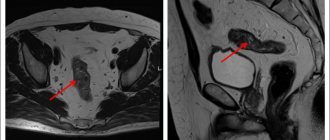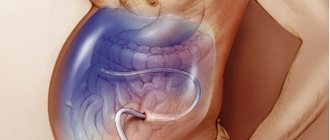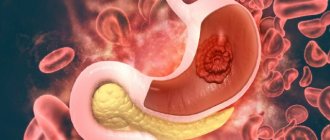According to surveys among teenagers, more than 40% of girls aged 13-16 years say they are overweight. More than 70% of girls 16 years old have already tried some kind of diet without consulting with specialists. Fashion today dictates the standard of beauty - a slender, tall woman. Teenage girls strive to look like models, ignoring both the individual characteristics of their figure and their height (a taller girl visually looks slimmer).
In some cases, the desire for beauty turns into a disease - anorexia. But how to identify signs of anorexia in a teenager and an adult woman?
How does anorexia begin?
Anorexia develops over a long period of time; it appears unnoticed either by the patient or by those around her. Usually it all starts with a healthy and reasonable desire to lose weight. There are periods of dietary restriction, addiction to diets and exercise. The girl brings her figure back to normal, but continues to lose weight: the thoughts of losing weight and the pleasure of a new figure are so exciting that the anorexic can no longer stop.
Where is the line between the natural desire to be slim and the painful desire to lose weight - at any cost?
Types and reasons
“Mannequin disease,” as anorexia is often called, has become a global scourge over the last 30-40 years. The abundance of glossy publications, television programs, photographs of successful people with beautiful figures, their popularity and demand for them, force girls from 14 years old, women up to 35 and even more, and even some men, to resort to extreme measures to be very thin.
This disease can also develop during stressful situations and hormonal imbalances.
There are different types of anorexia, each of which depends on specific causes:
• mental.
• symptomatic.
• nervous.
• medicinal or medicinal.
Having considered the reasons for the appearance of these types of dangerous illness, you can understand what causes anorexia. The rarest of them is a mental form that develops as a result of mental illnesses such as depression, paranoia, and schizophrenia. As for the symptomatic and medicinal type, they are based on the following physiological factors:
1. Abuse of medications (antidepressants).
2. Changes in the normal level of brain hormones - norepinephrine, serotonin, cortisol.
3. Diseases of any organs.
The most common form of anorexia is nervous, its causes lie in human psychology:
1. An irresistible desire to meet the standards imposed by society and the media.
2. Any violence - sexual and physical.
3. Striving for ideal – perfectionism.
4. Psychological trauma.
5. Strict control of your life. 6. An inferiority complex instilled in childhood.
Not only young girls with complexes who have no prospects and are in conflict with their parents suffer from anorexia. Among celebrities, well-established, famous and rich people, there are also many of them: Victoria Beckham, Angelina Jolie, Rachel Zoe, Mary-Kate Olsen.
Anorexia Symptoms: Dietary Changes
At the beginning of the disease, the patient reads a lot about proper nutrition and sports. Often girls, especially in adolescence, are addicted to various diets, many of which are harmful to the body, but few people are stopped by this. Initially, the patient refuses certain unhealthy foods - cakes, sweets, pastries. Gradually, dietary restrictions become more and more stringent: the girl stops eating all sweets, then foods high in fat: butter, hard cheese.
The list of “allowed” products is decreasing every month. As a result, the diet may be reduced to buckwheat and oatmeal, vegetables and water. At the same time, the amount of food consumed decreases. There are also frequent restrictions on the time of eating: girls take the popular advice “not to eat after six” very seriously, and do not allow violations of this rule, even if they did not have time to have dinner earlier. In the most severe cases, girls with anorexia begin to fast for several days
It is important to note that all symptoms of anorexia nervosa do not occur instantly, but stretch over time over months and years. Dietary restrictions are steadily increasing, the girl does not allow herself any indulgences, even if her weight has long since returned to normal.
Summarize
Anorexia nervosa is a dangerous disease that is difficult to recognize at the initial stage. After all, people with an eating disorder carefully hide the situation and do not consider it problematic. If ignored, the disease will lead to damage to all organs and death.
It is important to be attentive to your loved ones - spouses, teenage children. If you notice signs of anorexia nervosa, immediately hospitalize the patient - this will save his life.
After the course of treatment, do not loosen control - make sure that the person really eats well, and does not pretend. Stay in touch with your doctor and psychologist. This is the only way you will preserve your health and save your loved ones from a terrible illness.
Material prepared by: Alexander Sergeev Cover photo: Depositphotos
Sources
Anorexia nervosa Almost anorexic Anorexia nervosa
Signs of anorexia: unhealthy exercise and food purging
Girls with anorexia are often interested in various sports, but for them sports are not a way to maintain health, but a method of losing weight. The attitude towards sport as a method of weight loss manifests itself in many situations. If a girl with anorexia does not feel well, she will not miss a run - after all, this is necessary for losing weight. The choice of exercises and sports is also very specific: for quick weight loss - jogging, for “burning fat” in the waist area - abdominal exercises. At the same time, other muscle groups, for example, arm muscles, are of little interest to a girl suffering from anorexia.
Another popular weight loss option for anorexia is “food purging” by inducing vomiting and taking laxatives. If after eating, especially sweets, a girl regularly rushes to the toilet, there is a high probability of inducing vomiting. This is far from a harmless thing - due to gastric juice, tooth enamel is destroyed, and an inflammatory process develops in the throat.
Regular use of laxatives or diet pills is another common symptom of anorexia. The harm of long-term use of pharmacological drugs without indications and without medical supervision is obvious.
Risk factors
In addition to the supposed theories of the origin of the disease, scientists are also considering various risk factors. These conditions increase the risk of anorexia, but do not independently determine the formation of the disorder. The discovery of many forms of predisposition to the disease helped psychologists develop the prevention of eating disorders in adolescents.
Key risk factors:
- Low self-esteem, causing psychological discomfort.
- Dysfunctional family. Strictness, lack of a warm relationship with the father, formalization of education by parents can affect the development of anorexia;
- Negative experiences of interaction with peers, primarily formed in schools and other educational institutions. A girl may become depressed because of ridicule about her excess weight or other aspects of her appearance;
- Complicated family history. Having close relatives suffering from mental illness increases an individual's risk of developing the disease;
- Age. Anorexia most often occurs in women aged 15 to 35 years.
Doctors believe that hereditary factors in anorexia do not play as important a role as the psychological state. It is reliably known that the disease is not transmitted directly to children from parents.
At what weight does anorexia begin?
The limits of normal weight can be measured using the body mass index. Body mass index is calculated using the formula: I =m/h2, where: • m - weight in kilograms • h - height in meters For example, a girl’s weight = 50 kg, height = 170 cm. Accordingly, the body mass index in this case is equal to: BMI = 50: (1.70 × 1.70) = 17.3
BMI indicators according to WHO recommendations:
Lack of body weight is a reason to consult a doctor to determine the causes and ways of weight correction.
Body Mass Index (BMI) Calculator
Using this online calculator you can calculate your body mass index, BMI (from the English Body mass index - BMI). Using your body mass index, you can check the relationship between your body weight and your height and find out whether you are overweight or underweight. To calculate your body mass index (BMI), fill in the fields corresponding to your height and weight in the calculator. Enter your height and weight with an accuracy of tenths, then the calculation result will be most accurate.
Signs of anorexia: psychological changes
Despite the conspicuous low weight, the main symptoms of anorexia are still psychological. It is in the consciousness of a girl with anorexia that the most significant changes occur, which lead to mental disorder.
Anorexia begins as usual. The psychological impetus for starting to lose weight comes from ridicule or harsh statements from classmates/fellow students. Sometimes statements about fatness can be especially traumatic if they are said by a guy to whom the girl is not indifferent. The girl's self-esteem is reduced, and after such ridicule it decreases even more: she begins to think of herself as unattractive and inferior. At some point, the girl decides to lose weight.
She believes that if you change your appearance, you can immediately become attractive and popular among your peers and among the opposite sex. With such motivation, the girl quickly brings her weight back to normal. It’s good if she managed to lose weight wisely and avoid harmful diets, taking laxatives, weight loss drugs and inducing vomiting.
What prevents her from stopping losing weight?
Self-esteem in anorexia is very strongly related to body image. The first successes in losing weight cause real euphoria: the girl feels more beautiful and more successful than before. She sees the envious glances of her friends, the interested glances of guys, and this is a powerful incentive for her to continue working on her body. Work on the body usually continues with losing weight - the girl is used to this, and her consciousness has already firmly connected losing weight with popularity, success and happiness.
A patient with anorexia has a distorted perception of her body image: with extremely low weight, she continues to believe that in some places, for example, on the hips, there is fat that needs to be gotten rid of. It is virtually useless to convince her - neither for the parents nor for the psychologist.
| Find out more: What are the characteristics of teenage anorexia? |
In addition to the obsessive desire to lose weight, a person with anorexia usually communicates less with friends, and her circle of contacts narrows. Thoughts and hobbies are related to food: cooking, diets, calories. The mood of a patient with anorexia may be depressed or change frequently. Depression and sleep disturbances are common.
Physiological symptoms of anorexia
The physiological symptoms of anorexia vary depending on the stage of anorexia. When you lose weight significantly below normal, all systems and organs of the body suffer, but disorders are not always noticeable in the first stages of anorexia: a healthy young body has a margin of safety. The first visible signs of anorexia are:
- problems with the menstrual cycle
- constant weakness
- hair loss, brittle nails
The functioning of the endocrine system is disrupted, the concentrations of hormones, primarily sex hormones, change. With a lack of protein in food, the body begins to destroy muscle protein, including the heart muscle. This leads to various negative consequences...
| Read further: physiological disorders in anorexia |
When to see a doctor for anorexia?
As with most diseases, with anorexia the rule is true: the earlier treatment is started, the easier and faster the patient can be cured. If in the first stage of anorexia it is possible to do without medications, only with outpatient treatment, then in the last stages the patient ends up in intensive care, with a body weight below 35-40 kg and the risk of death. According to statistics, the mortality rate for anorexia without therapy is 5-10%.
Anorexia? We are ready to help you! Call us








